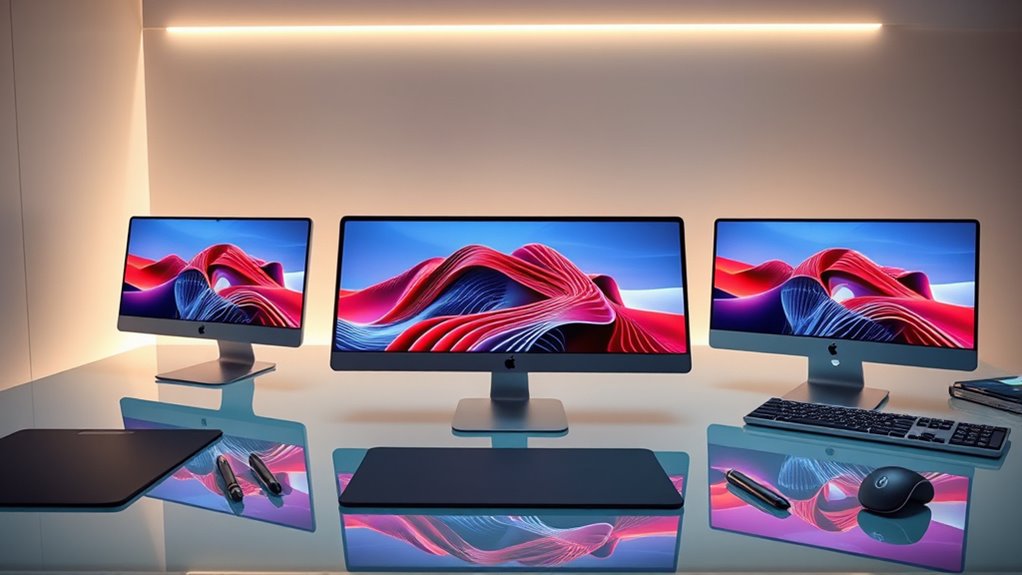For 2025, I recommend the top four Mac Studios with powerful M4 or M4 Pro chips, ample RAM, and fast SSDs for 3D rendering. These models offer high-res display support, versatile ports, and compact designs perfect for demanding workflows. They deliver the power and precision needed for complex scenes and large projects. Keep going to discover which setups can elevate your 3D work even further.
Key Takeaways
- The latest Mac Studio models with M4 Pro chips deliver top-tier CPU and GPU power for demanding 3D rendering tasks.
- Support for multiple high-resolution displays (6K, 8K) enhances workspace precision and detail management.
- High-speed NVMe SSDs and extensive connectivity options boost data transfer and workflow efficiency.
- Compact, sleek design ensures powerful performance in space-constrained professional environments.
- Upgradable memory and expandability options future-proof 3D rendering workflows through external peripherals and drives.
Apple Mac mini Desktop Computer with M4 Pro Chip (512GB SSD, 24GB RAM)
If you’re looking for a compact yet powerful desktop for 3D rendering, the Apple Mac mini with the M4 Pro chip is an excellent choice, especially for creative professionals who value space efficiency. Despite measuring just 5 inches square and weighing around 1.5 pounds, it packs impressive hardware, including a 12-core CPU and 16-core GPU, perfect for demanding tasks. The 24GB of unified memory and 512GB SSD ensure fast processing and storage. Its sleek aluminum design fits easily into tight spaces, while connectivity options like Thunderbolt 5, HDMI, and USB-C support multiple high-resolution displays. Quiet and cool under load, this mini powerhouse is ideal for efficient, high-performance rendering.
Best For: creative professionals and space-conscious users seeking a high-performance, compact desktop capable of handling demanding tasks like 3D rendering and video editing.
Pros:
- Compact design that fits easily into tight workspaces
- Powerful M4 Pro chip with a 12-core CPU and 16-core GPU for demanding workloads
- Supports multiple high-resolution displays simultaneously, including dual 6K and 8K options
Cons:
- Lack of USB-A ports, requiring adapters for some peripherals
- Power button placement at the bottom may be less intuitive
- Base memory of 24GB may be limiting for extremely intensive tasks without upgrades
Apple 2024 Mac mini Desktop Computer with M4 Chip
The Apple 2024 Mac mini with M4 chip is an ideal choice for 3D rendering professionals who need a compact, powerful workstation that can handle demanding creative tasks. Its small aluminum design measures just 5 inches square and weighs only 1.5 pounds, making it highly space-efficient. Powered by the M4 chip’s 10-core CPU, 10-core GPU, and Neural Engine, it delivers about 20% better CPU performance and up to 14% GPU gains over previous models. It supports multiple high-resolution displays, including 6K and 8K, and offers fast connectivity with Thunderbolt 4, HDMI, Ethernet, and Wi-Fi 6E. Despite its size, it packs impressive power for 3D rendering workflows.
Best For: creative professionals and 3D rendering experts seeking a compact yet powerful workstation capable of handling demanding workflows with high-resolution display support.
Pros:
- Compact, space-saving aluminum design with high portability
- Powerful M4 chip with significant CPU and GPU performance improvements
- Supports multiple high-resolution displays, including 6K and 8K, ideal for detailed rendering tasks
Cons:
- No USB-A ports, requiring adapters for some peripherals
- Power button placement on the bottom may be less intuitive
- Limited base memory (16GB), which could impact very demanding tasks without upgrades
Apple 2024 Mac mini with M4 Chip and 16GB RAM
Designed for professionals who need powerful performance in a compact form, the Apple 2024 Mac mini with M4 chip and 16GB RAM offers an ideal solution for 3D rendering tasks. Its small 5×5-inch footprint fits easily on any desk, yet it packs a punch with the M4 chip’s 10-core CPU and GPU, plus 16GB of unified memory. The device provides fast, fluid performance for demanding applications like Adobe Creative Cloud and 3D software. With multiple ports—including Thunderbolt, HDMI, and USB-C—it ensures flexible connectivity. Overall, this Mac mini balances power and portability, making it a versatile choice for professionals needing reliable, high-performance rendering capabilities.
Best For: professionals and creatives who need powerful, compact computing for demanding tasks like 3D rendering, video editing, and graphic design.
Pros:
- Tiny footprint fits easily on any desk space
- High-performance M4 chip with 10-core CPU and GPU for demanding applications
- Versatile connectivity options including Thunderbolt, HDMI, and USB-C
Cons:
- Limited internal storage starting at 256GB, which may require external options for large files
- No dedicated graphics card, relying solely on integrated GPU for rendering tasks
- Slightly higher price point compared to other compact mini PCs with similar specs
Apple 2024 Mac mini Desktop Computer with M4 Chip
For professionals seeking a compact yet powerful workstation, the Apple 2024 Mac mini with M4 chip stands out as an ideal choice. It packs a 10-core CPU and GPU, with 24GB of unified memory, ensuring fast, fluid performance for demanding 3D rendering tasks. Its small size—just five by five inches—fits easily next to monitors, making it versatile for any workspace. The Mac mini offers a range of ports, including Thunderbolt, HDMI, and Gigabit Ethernet, along with front-facing USB-C and a headphone jack for convenience. Built around Apple silicon, it delivers impressive speed, seamless ecosystem integration, and robust privacy protections—all in a sleek, space-efficient design.
Best For: professionals and enthusiasts seeking a compact, high-performance desktop that seamlessly integrates with the Apple ecosystem for demanding tasks like 3D rendering, creative workflows, and everyday productivity.
Pros:
- Compact size fits easily in any workspace while delivering powerful performance with M4 chip.
- Versatile connectivity options including Thunderbolt, HDMI, and Gigabit Ethernet for multiple device integrations.
- Seamless integration with iPhone and iPad, enabling features like Mirroring, message sharing, and FaceTime calls.
Cons:
- Limited upgrade options due to the integrated design of Apple silicon.
- Higher price point compared to some traditional mini PCs with similar specs.
- May require external peripherals for a complete workstation setup, adding to overall cost.
Factors to Consider When Choosing Mac Studio for 3D Rendering

When selecting a Mac Studio for 3D rendering, I focus on key factors like GPU power, memory capacity, and processor performance to guarantee smooth workflows. It’s also essential to contemplate storage options and connectivity features that support my project demands. By evaluating these aspects, I can choose a setup that delivers ideal speed and expandability for my 3D work.
GPU Power and Cores
The GPU power in a Mac Studio is mainly determined by its number of cores, which directly affects its ability to handle demanding 3D rendering tasks. More cores mean greater parallel processing, allowing the GPU to work on multiple complex calculations simultaneously. This results in faster rendering times, especially when dealing with intricate textures, lighting, and shading. Additionally, a higher core count improves hardware-accelerated ray tracing, boosting realism in visualizations. It also enhances the system’s capacity to manage multiple high-resolution displays and large models without slowing down. For professional 3D artists, selecting a Mac Studio with a GPU that has ample cores guarantees smoother viewport navigation and more efficient workflows, making it an essential factor in choosing the right machine for intense rendering tasks.
Memory Capacity and Speed
Choosing the right memory capacity and speed is essential for peak 3D rendering performance on a Mac Studio. Higher memory capacity lets you handle larger, more complex models without slowing down, which is critical when working with detailed assets. I recommend at least 32GB of high-speed unified memory for excellent results, especially with resource-intensive software. Faster RAM reduces rendering times by enabling quicker data transfer between memory and the GPU or CPU, improving workflow efficiency. Memory bandwidth also plays a crucial role in managing large textures and detailed assets smoothly. Upgrading to faster memory modules can greatly boost overall responsiveness, making it easier to work seamlessly on demanding projects. In short, investing in ample, speedy memory ensures your Mac Studio can keep up with your 3D rendering needs.
Processor Performance Levels
Processor performance levels play a vital role in maximizing your Mac Studio’s 3D rendering capabilities. A powerful CPU with more cores speeds up rendering times for complex scenes and detailed models by distributing tasks across multiple threads. Advanced architecture and higher clock speeds improve handling demanding workflows like simulations and texture baking. Faster processors also boost real-time viewport responsiveness, making your workflow smoother and more efficient. Upgrading to a Mac Studio with superior processor performance ensures your system can manage larger projects and more complex scenes without bottlenecks. As 3D rendering demands grow, investing in a setup with top-tier processing power offers better scalability for future projects, saving you time and enhancing productivity. The right processor level directly translates into faster, more efficient rendering experiences.
Storage Options and Speed
Have you considered how storage speed can impact your Mac Studio’s 3D rendering workflow? Faster storage options like NVMe SSDs drastically cut load times and boost overall efficiency when handling large, complex files. Drives with read/write speeds of 7.5GB/s or more can better manage the data transfer demands of intricate projects, ensuring smoother rendering. However, storage capacity also matters; larger drives may slow down if not paired with high-speed interfaces, which can hinder performance. External solutions via Thunderbolt 4 or USB-C can supplement internal storage, offering both speed and space for extensive assets. Choosing a Mac Studio with configurable storage lets you tailor performance, enabling quick access to files and seamless rendering. Balancing speed and capacity is key to optimizing your 3D workflow.
Connectivity and Expandability
When selecting a Mac Studio for 3D rendering, ensuring it offers ample connectivity and expandability is essential for a smooth workflow. Look for multiple Thunderbolt 4 and USB-C ports to connect high-speed external drives, graphics tablets, and peripherals. Check if it has expansion options like SD card slots or additional PCIe slots to boost storage and hardware capabilities. Support for high-bandwidth connections such as HDMI 2.1 and 10Gb Ethernet is crucial for fast data transfer and multi-display setups. Additionally, verify that the device can handle sufficient RAM and GPU configurations to prevent bottlenecks during complex rendering tasks. Compatibility with external docking stations or hubs is also vital, as it streamlines cable management and expands connectivity options, keeping your workspace efficient and organized.
Frequently Asked Questions
How Does GPU Performance Impact 3D Rendering Speed on Mac Studios?
GPU performance directly impacts my 3D rendering speed because it handles the complex calculations needed for rendering detailed visuals. A powerful GPU reduces rendering time, allowing me to work more efficiently and iterate faster. On Mac Studios, a high-performance GPU like the M2 Ultra or M1 Max makes a noticeable difference, especially with large, intricate scenes, giving me smoother workflows and quicker project completion.
What Are the Best Storage Options for Large 3D Project Files?
For large 3D project files, I recommend using fast SSD storage, preferably Thunderbolt 3 or 4 external drives, for quick access and transfer speeds. Internal SSDs are ideal if you can customize your Mac Studio. I also keep backups on reliable cloud services or external drives to prevent data loss. Combining internal and external SSDs gives me the best balance of speed and capacity for my projects.
How Important Is RAM Capacity for Complex 3D Rendering Tasks?
They say “more hands make light work,” and in 3D rendering, that’s true for RAM. I’ve learned that having ample RAM is essential for handling complex scenes and multitasking smoothly. It prevents lag, speeds up rendering, and lets me work without constant crashes. For demanding projects, I always recommend at least 32GB—more if possible—to keep my workflow seamless and efficient.
Can Mac Studios Handle Real-Time 3D Rendering and Viewport Navigation?
Absolutely, Mac Studios can handle real-time 3D rendering and viewport navigation quite well. With their powerful processors and advanced GPUs, I’ve found them to be smooth and responsive, even during complex scenes. The combination of high RAM capacity and fast storage boosts performance further. If you’re working on demanding projects, Mac Studios offer the reliability and speed you need for seamless real-time editing and navigation.
What Connectivity Features Are Essential for Seamless 3D Workflow Integration?
Think of your workspace as a bustling city; seamless connectivity is the main highway. For 3D workflows, Thunderbolt ports are like fast lanes, ensuring quick data transfer. USB-C ports act as versatile arteries, while Wi-Fi 6 and Bluetooth 5.0 keep wireless connections smooth. Having multiple ports and high-speed options allows me to transfer large files effortlessly, connect external displays, and sync peripherals, keeping my creative city running without traffic jams.
Conclusion
Choosing the right Mac Studio for 3D rendering isn’t just about raw power; it’s about unleashing your creative potential. Whether I seek the cutting-edge M4 Pro or the reliable M4 chip, each option offers a different level of performance and precision. It’s like balancing the thrill of pushing boundaries against the comfort of familiarity. In this race for perfection, I realize it’s not just technology—it’s about turning visions into reality with every render.











